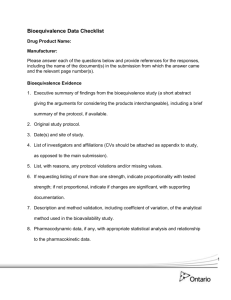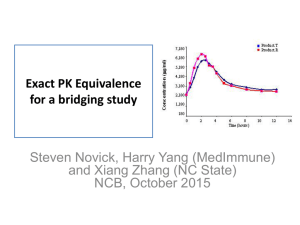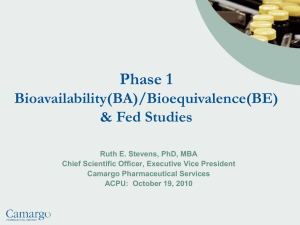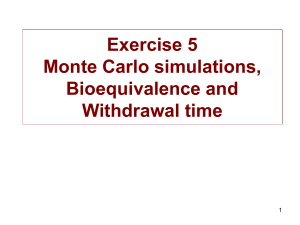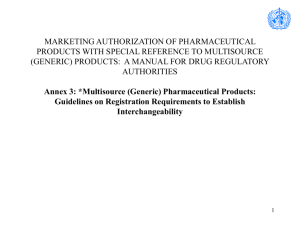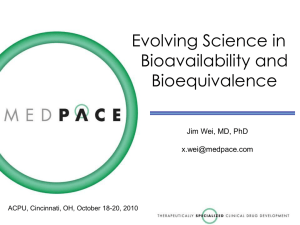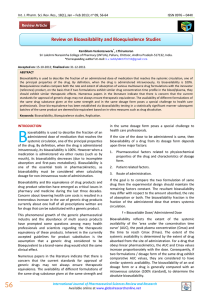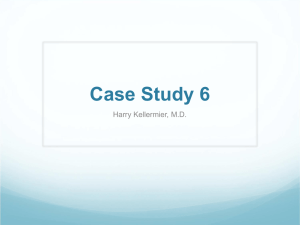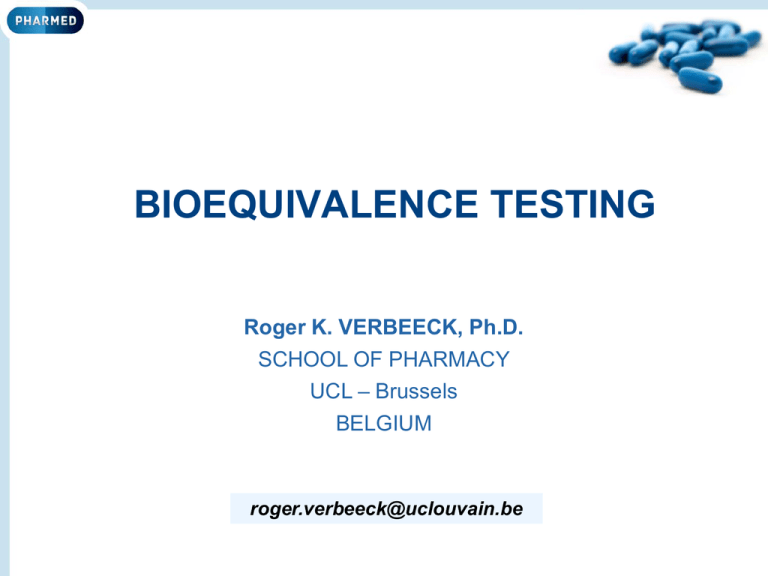
BIOEQUIVALENCE TESTING
Roger K. VERBEECK, Ph.D.
SCHOOL OF PHARMACY
UCL – Brussels
BELGIUM
roger.verbeeck@uclouvain.be
OUTLINE
Concept of bioavailability
Historical cases of bio-inequivalence
Bioequivalence testing : EMA and FDA
guidelines
Study designs
Bioequivalence criteria
Special issues
A representative sample of the
slides that will be presented and
discussed during the course is
displayed hereafter.
PHARMACOKINETICS
Temporal characteristics of drug effect and relationship to the
therapeutic window (e.g., single dose, oral administration).
BIOAVAILABILITY
The extent and the rate to which a drug
substance or its therapeutic moiety is
delivered from a pharmaceutical form
into the general circulation
absolute bioavailability
relative bioavailability
ABSOLUTE BIOAVAILABILITY
F
AUC
AUC
oral
iv
DOSE
DOSE
iv
oral
RELATIVE BIOAVAILABILITY
tablet A
□ tablet B
Frel
AUC
f ormA
AUC
f ormB
BIOAVAILABILITY
AUC1AUC2AUC3
AUC1=AUC2=AUC3
Cmax
Tmax
Changes in extent and/or rate of absorption influence the
drug plasma concentration-time profile and may therefore
affect the therapeutic efficacy
BIOAVAILABILITY
formulation and physicochemical factors influencing drug
absorption and bioavailability
BIOAVAILABILITY
The practical importance of BA/BE testing has been
demonstrated by a number of clinical reports in the
60’s and the 70’s documenting medical problems due
to bio-inequivalence
To allow prediction of the therapeutic effect the
performance of the pharmaceutical dosage form
containing the active substance should be known and
reproducible
BIOAVAILABILITY
Outbreak of phenytoin
intoxication around 1970 in
Queensland, Australia
Calcium sulphate dihydrate in
the phenytoin capsules had
been replaced by lactose
Tyrer et al.: Outbreak of anticonvulsant intoxication in
an Australian city. Brit. Med. J. 4: 271-273, 1970.
BIOAVAILABILITY
B urroughs W ellc ome
SERUM
C O N C E N TR A TIO N
(ng/m l)
2.5
D avis-E dwards
2.0
A P C batc h B 15703
A P C batc h 24928
1.5
1.0
0.5
0.0
0
1
2
3
4
5
6
T IME (h o u r s)
Lindenbaum et al.: Variation in the biologic availability of digoxin
from four preparations. New Engl. J. Med. 1344-1347, 1971.
BIOEQUIVALENCE
“Two medicinal products containing the same active
substance are considered bioequivalent if they are
pharmaceutically equivalent or pharmaceutical
alternatives and their bioavailabilities (rate and extent
of absorption) after administration in the same molar
dose lie within acceptable predefined limits. These
limits are set to ensure comparable in vivo
performance, i.e. similarity in terms of safety and
efficacy.”
GUIDELINE ON THE INVESTIGATION OF BIOEQUIVALENCE, EMA
(LONDON), 2010.
BIOEQUIVALENCE TESTING
BE tests are not only required
for the registration of generic
drugs but are also carried out
during the development of
new drugs: e.g. during
scale-up and for post-approval
changes (SUPAC).
IMMEDIATE RELEASE DOSAGE FORMS
http://www.ema.europa.eu/docs/en_GB/document_library/Scientific_guideline/2010/01/WC500070039.pdf
FDA Guidance for Industry
http://www.fda.gov/downloads/Drugs/GuidanceComplianceRegulatoryInformat
ion/Guidances/ucm072872.pdf
EMA Guideline on the Investigation
of Bioequivalence, 2010
STUDY DESIGN
- standard design: randomized, two-period,
two-sequence, single dose cross-over
design
- alternative designs: parallel design
(substances with very long half-lives) and
replicate designs (in case of highly
variable drugs or drug products)
2 x 2 CROSS-OVER DESIGN
subjects
R
A
N
D
O
M
I
Z
A
T
I
O
N
period 1
sequence 1
R
sequence 2
T
period 2
W
A
S
H
O
U
T
T
R
TWO-GROUP PARALLEL DESIGN
subjects
R
A
N
D
O
M
I
Z
A
T
I
O
N
group 1
TEST
group 2
REFERENCE
REPLICATE DESIGN
4-period, 2-sequence, 2-formulation design
period
subjects
R
A
N
D
O
M
I
Z
A
T
I
O
N
I
II
III
IV
sequence 1
T
R
T
R
sequence 2
R
T
R
T
wash-out
EMA Guideline on the Investigation
of Bioequivalence, 2010
STUDY SUBJECTS
- the number should be based on an appropriate
sample size calculation ( 12),
- healthy volunteers to reduce variability,
- strict inclusion/exclusion criteria,
- subjects could belong to either sex,
- preferably non-smokers and without a history of
alcohol or drug abuse,
- patients, if the investigative active substance is
known to have serious adverse effects considered
unacceptable for healthy volunteers
EMA Guideline on the Investigation
of Bioequivalence, 2010
o
SAMPLING TIMES
“The sampling schedule should
include frequent sampling around
the predicted tmax to provide a
reliable estimate of peak exposure.
In particular, the sampling schedule
should be planned to avoid Cmax
being the first point of the
concentration-time curve.”
Sampling times: 0, 0.5, 1, 2, 4, 6, 8 and 12 hours.
EMA Guideline on the Investigation
of Bioequivalence, 2010
SAMPLING TIMES
“The sampling schedule should also cover the plasma
concentration time curve long enough to provide a
reliable estimate of the extent of exposure which is
achieved if AUC0-t covers at least 80% of AUC0-.
At least 3 to 4 samples are during the terminal loglinear phase in order to reliably estimate the terminal
rate constant, which is needed for a reliable estimate
of AUC0-.”
EMA Guideline on the Investigation
of Bioequivalence, 2010
PRIMARY PARAMETERS:
- AUC0-t or AUC0-72h: extent of absorption
- Cmax: extent and rate of absorption
- Tmax: rate of absorption
RATE OF ABSORPTION
partial AUC
For drug products where rapid absorption is of
importance, partial AUCs can be used as a measure
of early exposure (FDA Guidance for Industry, 2003).
The partial area can in most cases be truncated at
the population median of Tmax values for the
reference formulation: AUCtmax
EMA Guideline on the Investigation
of Bioequivalence, 2010
BIOANALYTICAL METHODOLOGY
The bioanalytical part of BE trials should be
performed in accordance with the principles
of Good Laboratory Practice (GLP).
EMA draft Guideline on Validation of
Bioanalytical Methods, London, November
2009.
EMA Guideline on the Investigation
of Bioequivalence, 2010
BIOEQUIVALENCE CRITERIA:
are based on the calculation of a 90%
confidence interval according to the two onesided tests procedure of Schuirmann
D.J. Schuirmann: A comparison of the two one-sided tests procedure
and the power approach for assessing the equivalence of average
bioavailability. J. Pharmacokinet. Biopharm. 15: 657-680, 1987.
EMA Guideline on the Investigation
of Bioequivalence, 2010
The pharmacokinetic parameters under consideration (e.g.
AUC0-t, Cmaxin case of a single dose BE study) should be
analysed using ANOVA.
The data should be transformed prior to analysis using a
logarithmic transformation.
The terms to be used in the ANOVA model are usually
sequence, subject within sequence, period and formulation.
A statistical evaluation of tmax is not required. However, if rapid
release is claimed to be clinically relevant and of importance for
onset of action or is related to adverse events , there should be
no apparent difference in median tmax and its variability between
test and reference product.
90% CONFIDENCE INTERVAL
a 90% confidence interval has to be
calculated around the ratio of geometric
means obtained for AUC (and Cmax)
following administration of test and
reference preparation
this ratio of geometric means is called
the point estimate
EMA Guideline on the Investigation
of Bioequivalence, 2010
For Cmax and AUC0-t the 90% confidence interval for
the ratio of the test and reference products should be
contained within the acceptance interval of 80.00125.00%.
In specific cases of products with a narrow
therapeutic range, the acceptance interval may
need to be tightened. Moreover, for highly variable
drug products the acceptance interval for Cmax may
in certain cases be widened (by using the reference
scaled average bioequivalence approach).
90% CONFIDENCE INTERVAL
90% CI 1.04 (0.91 – 1.20)
point
estimate
0.80
1.04
1.25
NARROW THERAPEUTIC INDEX DRUGS
EMA BE guideline - 2010
In specific cases of products with a narrow
therapeutic index (NTI), the acceptance interval
for AUC should be tightened to 90.00-111.11%.
Where Cmax is of particular importance for
safety, efficacy or drug level monitoring the
90.00-111.11% acceptance interval should also
be applied for this parameter.
It is not possible to define a set of criteria to
categorise drugs as NTI drugs and it must be
decided case by case if an active substance is
and NTI drug based on clinical considerations.
BIOPHARMACEUTICS CLASSIFICATION
SYSTEM (BCS)
permeability
dissolution
solubility
solubility, dissolution and permeability are the 3
major factors controlling the oral absorption of drug
substances from IR oral medicinal products
BIOPHARMACEUTICS CLASSIFICATION
SYSTEM (BCS)
Class I
Class II
High solubility
High permeability
Low solubility
High permeability
Class III
Class IV
High solubility
Low permeability
Low solubility
Low permeability
Amidon et al.: A theoretical basis for a biopharmaceutic drug classification: the
correlation of in vitro drug product dissolution and in vivo bioavailability. Pharm.
Res. 12: 413-420, 1995.
BIOPHARMACEUTICS CLASSIFICATION
SYSTEM (BCS)
the BCS was developed for regulatory
applications: to provide a basis for replacing,
in certain cases, in vivo BE studies by
equally or more accurate in vitro tests
biowaiver: an acceptance for replacing an in
vivo BE study with in vitro dissolution testing

